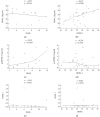ProBDNF as an Indicator of Improvement among Women with Depressive Episodes
- PMID: 35448545
- PMCID: PMC9027259
- DOI: 10.3390/metabo12040358
ProBDNF as an Indicator of Improvement among Women with Depressive Episodes
Abstract
Depression is a chronic psychiatric disorder with a heavy socioeconomic burden. Studies on biomarkers are needed to comprehend the pathophysiology of depression and to improve treatment outcomes. Research points to the importance of imbalance between mature brain-derived neurotrophic factor (BDNF) and its precursor, pro-brain-derived neurotrophic factor (proBDNF), in the pathophysiology of mood disorders and the potential neurodegenerative role of calcium-binding protein B (S100B). Our objective was to compare BDNF, proBDNF, and S100B serum levels before and after the treatment of acute depressive episodes and to assess their correlation with the severity of symptoms and history of stress. We also aimed to investigate the differences in BDNF, proBDNF, and S100B levels between depression in the course of bipolar disorder (BD) and major depressive disorder (MDD). We recruited 31 female patients diagnosed with BD or MDD who were hospitalized due to current depressive episodes. The patients had their serum BDNF, proBDNF, and S100B levels evaluated using the ELISA method upon admission and after the symptoms improved, at discharge. We found that proBDNF levels decreased significantly with the treatment (p = 0.0478), while BDNF and S100B levels were not altered significantly. No differences in biochemical parameters between MDD and BD subjects were observed. Consequently, we concluded that a decrease in serum proBDNF levels could be considered a biomarker of recovery from depressive episodes.
Keywords: biomarkers; bipolar disorder; brain-derived neurotrophic factor; depression; mood disorders.
Conflict of interest statement
The authors declare no conflict of interest.
Figures


Similar articles
-
Decreased serum levels of mature brain-derived neurotrophic factor (BDNF), but not its precursor proBDNF, in patients with major depressive disorder.PLoS One. 2012;7(8):e42676. doi: 10.1371/journal.pone.0042676. Epub 2012 Aug 3. PLoS One. 2012. PMID: 22880079 Free PMC article.
-
Analysis of blood mature BDNF and proBDNF in mood disorders with specific ELISA assays.J Psychiatr Res. 2021 Jan;133:166-173. doi: 10.1016/j.jpsychires.2020.12.021. Epub 2020 Dec 13. J Psychiatr Res. 2021. PMID: 33341455
-
Altered expression of BDNF, BDNF pro-peptide and their precursor proBDNF in brain and liver tissues from psychiatric disorders: rethinking the brain-liver axis.Transl Psychiatry. 2017 May 16;7(5):e1128. doi: 10.1038/tp.2017.95. Transl Psychiatry. 2017. PMID: 28509900 Free PMC article.
-
Brain-derived neurotrophic factor as a biomarker for mood disorders: an historical overview and future directions.Psychiatry Clin Neurosci. 2010 Aug;64(4):341-57. doi: 10.1111/j.1440-1819.2010.02113.x. Psychiatry Clin Neurosci. 2010. PMID: 20653908 Review.
-
Peripheral brain-derived neurotrophic factor (BDNF) as a biomarker in bipolar disorder: a meta-analysis of 52 studies.BMC Med. 2015 Nov 30;13:289. doi: 10.1186/s12916-015-0529-7. BMC Med. 2015. PMID: 26621529 Free PMC article.
Cited by
-
Peripheral S100B Protein Levels in Five Major Psychiatric Disorders: A Systematic Review.Brain Sci. 2023 Sep 16;13(9):1334. doi: 10.3390/brainsci13091334. Brain Sci. 2023. PMID: 37759935 Free PMC article. Review.
-
Evaluation of serum brain-derived neurotrophic factor, IL-6, IL-10, and TNF-a cognitive function, and sleep quality in elderly patients with major depressive disorder and somatic symptoms.J Med Biochem. 2025 Jun 13;44(3):568-575. doi: 10.5937/jomb0-53387. J Med Biochem. 2025. PMID: 40821647 Free PMC article.
-
Progress and trends of research on mineral elements for depression.Heliyon. 2024 Jul 31;10(15):e35469. doi: 10.1016/j.heliyon.2024.e35469. eCollection 2024 Aug 15. Heliyon. 2024. PMID: 39170573 Free PMC article.
-
Function and application of brain‑derived neurotrophic factor precursors (Review).Int J Mol Med. 2025 Jul;56(1):105. doi: 10.3892/ijmm.2025.5546. Epub 2025 May 9. Int J Mol Med. 2025. PMID: 40341415 Free PMC article. Review.
References
-
- GBD 2017 Disease and Injury Incidence and Prevalence Collaborators Global, regional, and national incidence, prevalence, and years lived with disability for 354 diseases and injuries for 195 countries and territories, 1990–2017: A systematic analysis for the Global Burden of Disease Study 2017. Lancet. 2018;392:1789–1858. doi: 10.1016/S0140-6736(18)32279-7. - DOI - PMC - PubMed
-
- Molendijk M.L., Bus B.A., Spinhoven P., Penninx B.W., Kenis G., Prickaerts J., Voshaar R.C.O., Elzinga B.M. Serum levels of brain-derived neurotrophic factor in major depressive disorder: State-trait issues, clinical features and pharmacological treatment. Mol. Psychiatry. 2011;16:1088–1095. doi: 10.1038/mp.2010.98. - DOI - PMC - PubMed
Grants and funding
LinkOut - more resources
Full Text Sources
Miscellaneous

